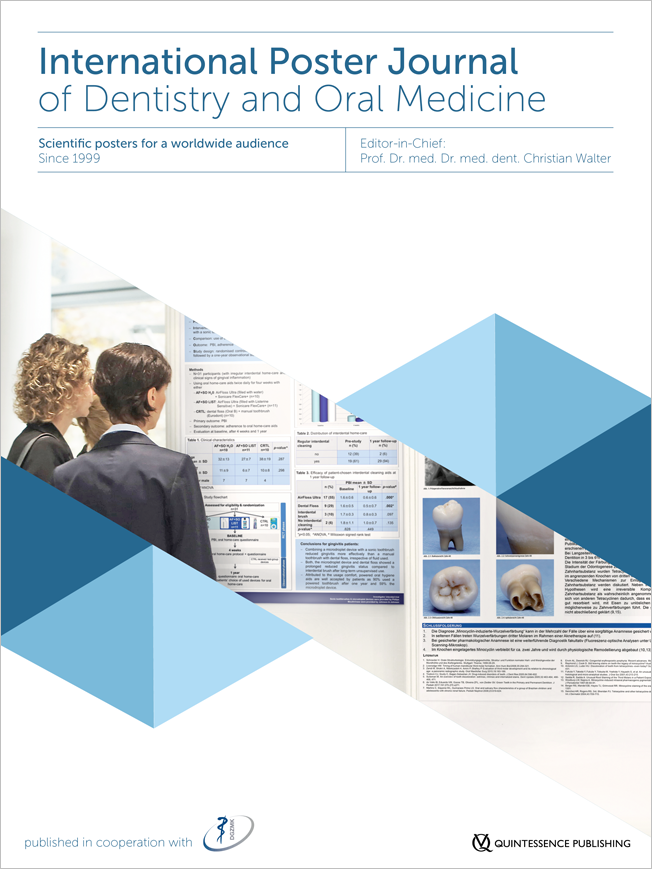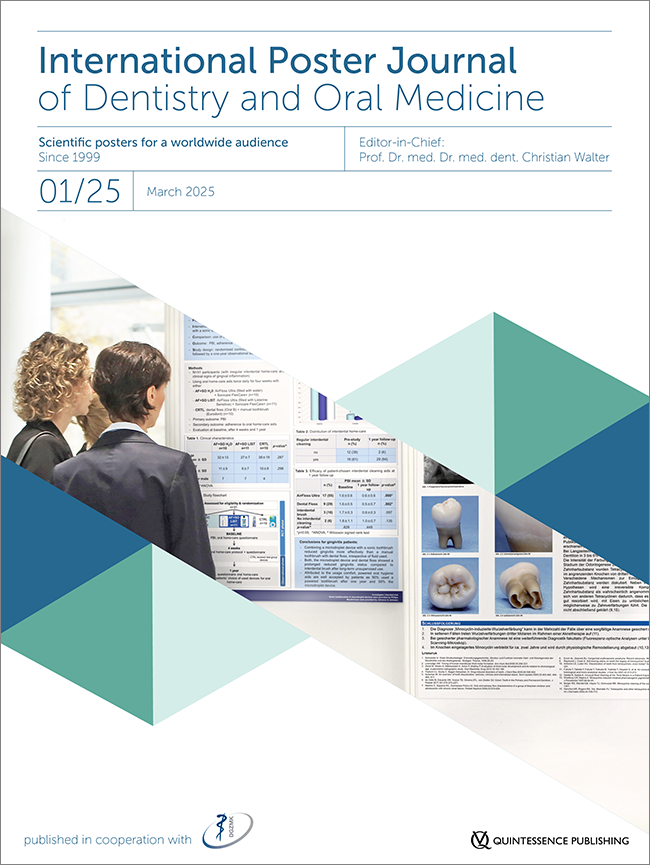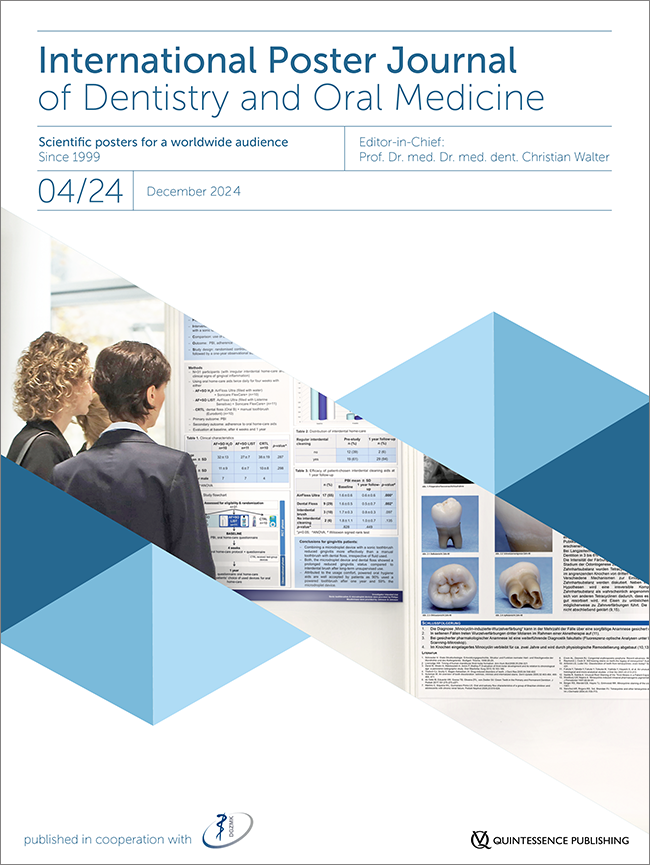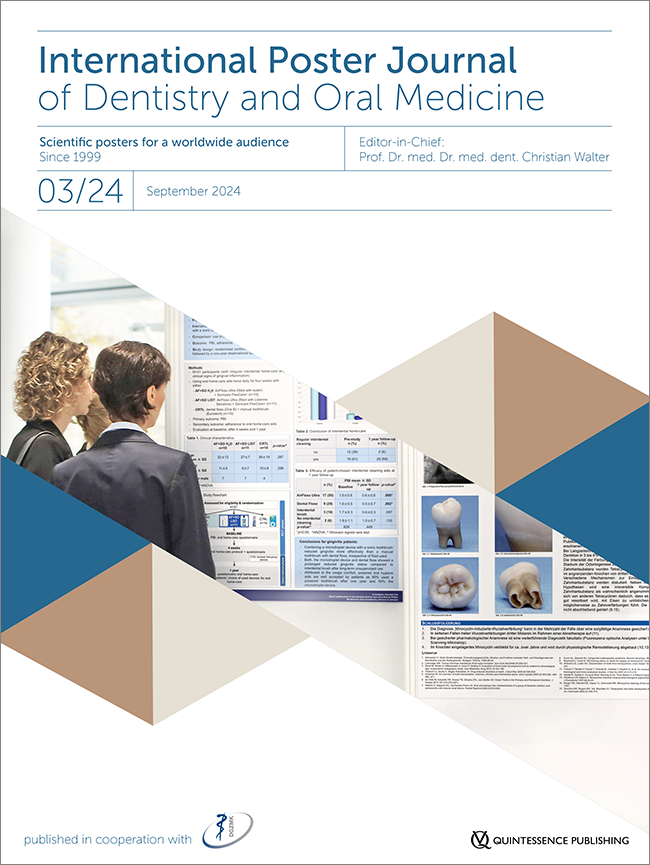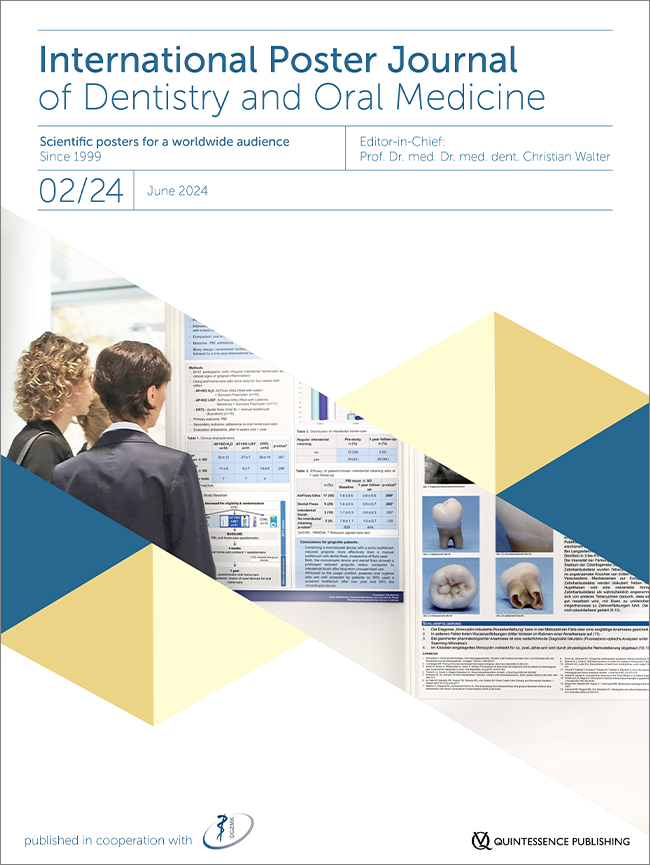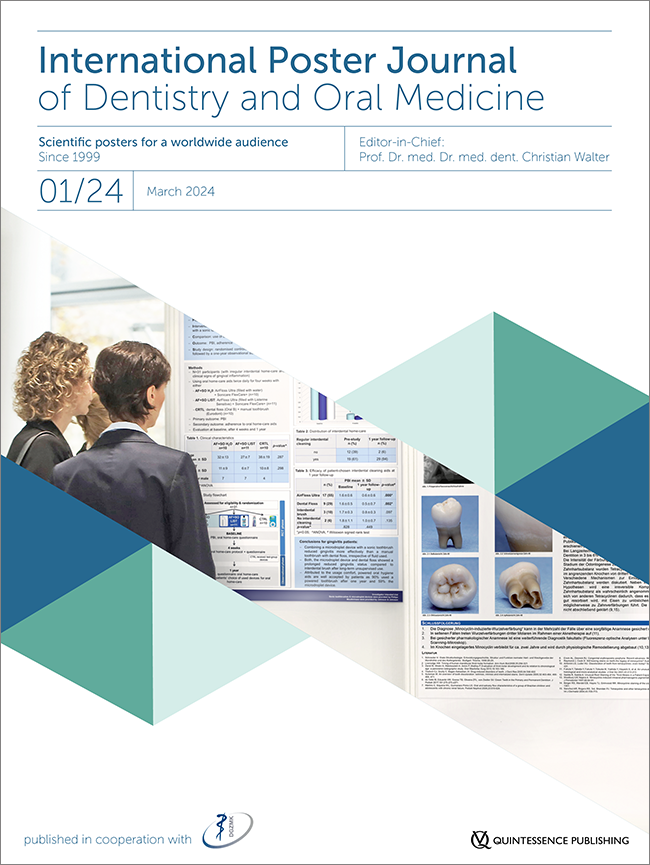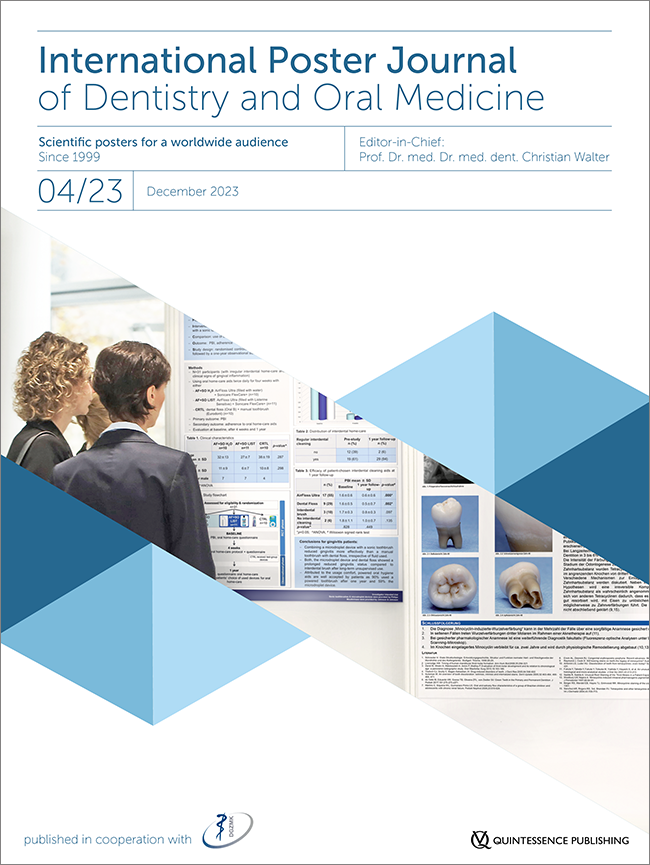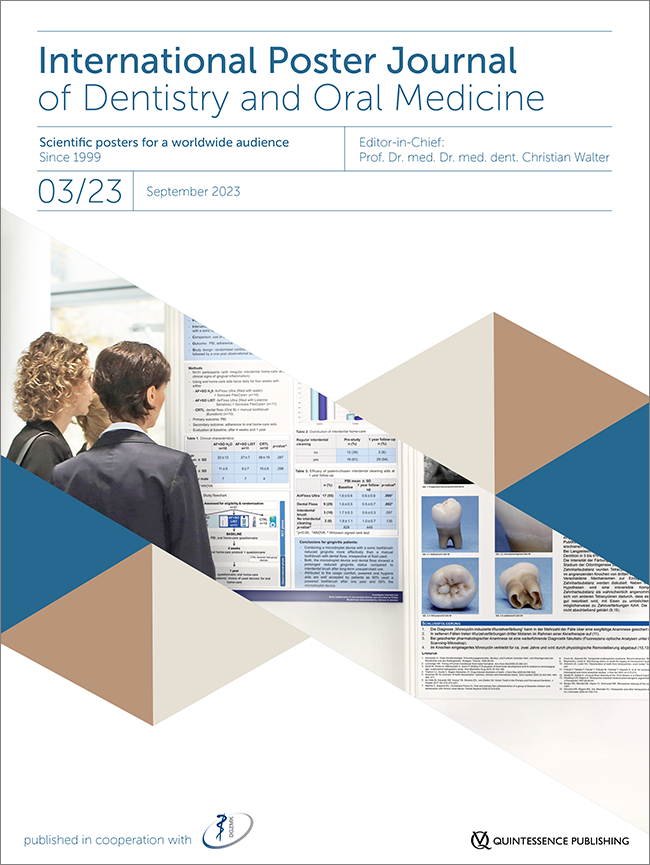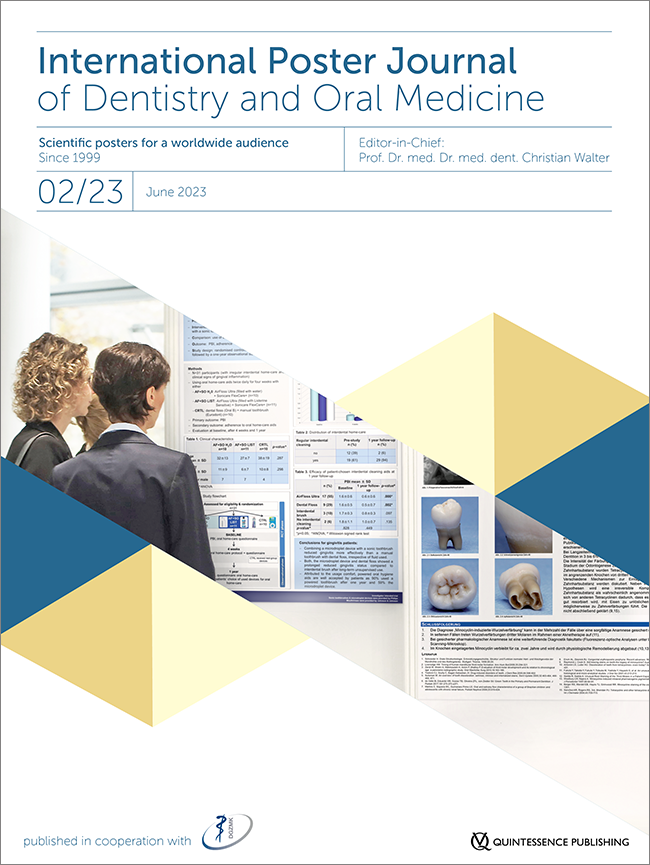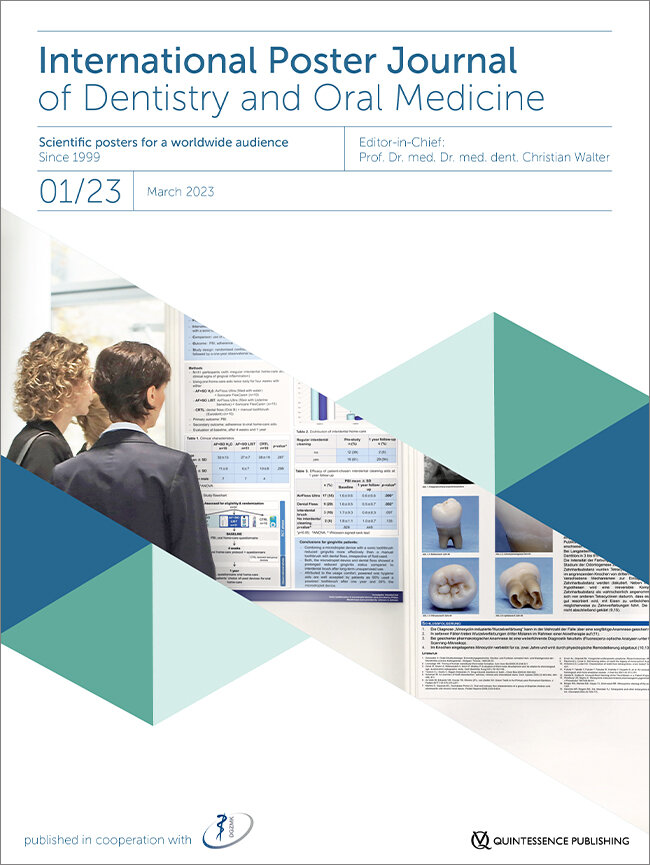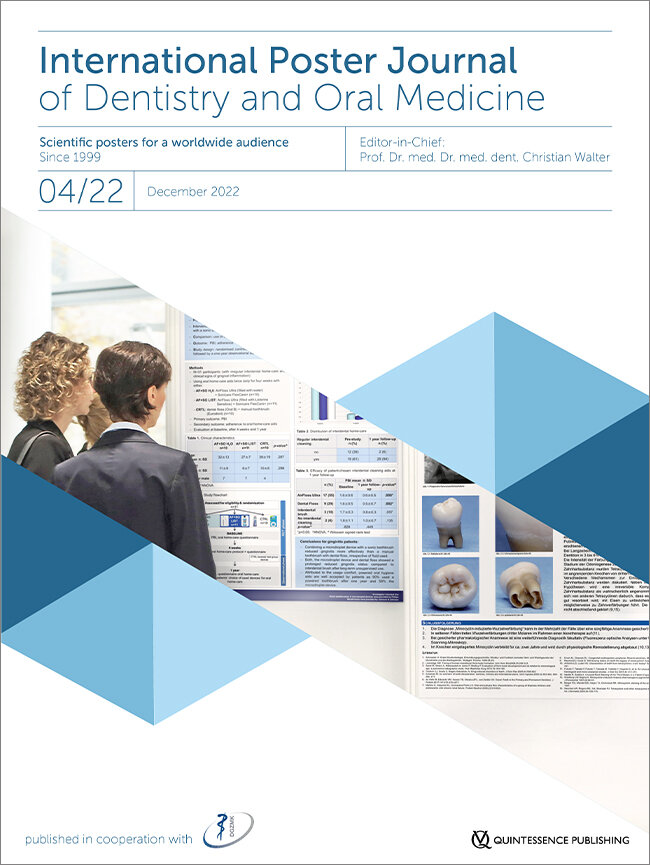Poster 2689, Sprache: Englisch, DeutschKetteler, Judith / Poggenpohl, Laura / van der Bijl, Nils / Daume, LindaDie klinische Diagnose Gingivahyperplasie kann multiple Ursachen haben, bei denen erworbene von erblichen zu unterscheiden sind. Nur pathohistologisch zu unterscheiden sind dabei die echte Zellvermehrung von der Volumenvergrößerung der Zellen. Mit unter 100 bekannten Fällen weltweit ist das Temple-Baraitser Syndrom, eine erbliche sehr seltene, autosomal dominante genetische Fehlfunktion. Charakteristisch sind eine geistige Retardierung, frühkindliche Hypotonie, Epilepsie, kleine oder nicht vorhandene Daumen- und Zehennägel, sowie bestimmte Gesichtszüge. Das Temple-Baraitser Syndrom ist bedingt durch Mutationen im KCNH1 Genom am chromosomalen Ort 1q32.2. Eine 10-Jährige Patientin stellte sich in Begleitung ihrer Eltern vor. Humangenetisch war bei ihr das seltene Temple-Baraitser Syndrom nachgewiesen worden. Bei allen bisher bekannten Fällen des Syndroms wurde, wie bei dieser Patientin, von epileptischen Anfällen und autistischem Verhalten berichtet. Das Mädchen nahm daher auch täglich Ospolot (Antikonvulsivum) ein. Die Patientin wies den typischen Phänotyp mit einem tiefen Haupthaaransatz, flacher Stirn, nach unten geneigten Lidspalten, breiter, eingedrückter Nasenbrücke mit nach anterior gerichteten Nasenlöchern, kurzem Nasensteg, langem Philtrum und hohem Gaumen auf. Auch die in später Kindheit typische Gingivahyperplasie war bei dieser Patientin eindrücklich feststellbar. Es lag ein Milchzahngebiss mit schlechter Hygienefähigkeit aufgrund eingeschränkter Compliance und der ausgeprägten Gingivahyperplasie vor. Die bleibende Dentition war -soweit radiologisch beurteilbar- angelegt. Die Gingivahyperplasie ist im Fall dieser Patientin höchstwahrscheinlich Syndrom- und Antikonvulsiva-assoziiert. Die Therapie einer Gingivahyperplasie ist ursachenabhängig und besteht in der Regel in der Herstellung einer möglichst guten Hygienefähigkeit des Gebisses und in Einzelfällen in einer Abtragung des überschüssigen Gewebes. Die Familie wurde daher angehalten die Mundhygiene zu verbessern. Es wird der weitere Zahndurchbruch abgewartet und dieser bei Bedarf kieferorthopädisch unterstützt. Ein gänzliches Absetzen der Medikamente ist häufig, wie die Antikonvulsiva in diesem Fall, nicht möglich.
Schlagwörter: Temple-Baraitser Syndrom, Gingivahyperplasie, Antikonvulsiva
Poster 2690, Sprache: Englisch, DeutschJaber, Mona / Daume, Linda / Hanisch, Marcel / Jung, Susanne / Jaber, MohammedZiel dieser Studie war es, inwieweit durch die Anwendung eines neuen konservativen Behandlungsansatzes (aus neurologischer und zahnmedizinischer Sicht) bei Kiefer- und Gesichtsschmerzen, eine Schmerzreduktion erreicht werden kann.42 Schmerzpatienten stellten sich nach erfolgloser zahnärztlicher Fokussuche in der MKG-Ambulanz vor. Kriterium waren Kiefer- und Gesichtsschmerzen. Davon war vorab bei 25 Patienten eine stationäre neurologische Abklärung aufgrund Schmerzexazerbation erfolgt. Unterteilt wurde ebenfalls, ob die Patienten Neuroleptika bekamen. Alle Patienten wurden in der MKG nach dem gleichen Protokoll behandelt. Alle Patienten bekamen insgesamt 2 Fragebögen. Einen vor der Therapie und den 2. nach 6-wöchigem Tragemodus der Schiene.Bei der 1. Sitzung erfolgt bei den Patienten ein osteopathisches Screening, Teil der 1. Sitzung ist auch eine ausführliche Anamnese. Bei der 2. Sitzung erfolgt die osteopathische Behandlung während der Biss durch Watterollen kontaktlos ist. Die beiden wesentlichen Einflüsse auf die Kiefergelenksposition werden manipuliert, durch Watterollen auf die Okklusion und durch die osteopathische Behandlung vor allem der Kaumuskulatur. Anschließend wird direkt die Bissnahme ohne jegliche Manipulation genommen. Bei der 3. Sitzung erfolgt erst die osteopathische Behandlung und danach das Einsetzen der Schiene. Die Patienten mussten die Schiene für 6 Wochen permanent tragen (außer Nahrungsaufnahme) zwecks Neuromuskulärer Anpassung. Die Patienten bekamen in dieser Phase Physiotherapie. 6 Wochen nach dem Tragen der Schiene wurden die Patienten zur 1. Schienenkontrolle nach osteopatischer Behandlung einbestellt. Jetzt wurde der 2. Fragebogen von den Patienten ausgefüllt.Ergebnisse sah wie folgt aus: 11 Patienten haben die Schiene nachts und stundenweise Tagsüber getragen. Bei den Patienten war eine entspannte Kaumuskulatur morgens beschrieben. Die Schmerzintensität und die anfänglichen Symptome wurden reduziert, waren aber noch vorhanden. Bei den 31 Patienten die sich an den intensiven Tragemodus der Schiene gehalten haben, kam es bei 22 Patienten zu einer Symptom- und Beschwerdefreiheit. Und bei den übrigen 9 Patienten waren die Symptome und Beschwerden noch vorhanden, wurden aber als deutlich reduziert beschrieben.Bei den 42 behandelten Patienten lässt sich die Aussage treffen, dass der Therapieansatz erfolgsversprechend bei Kiefer- und Gesichtsschmerzen einzusetzen ist.
Schlagwörter: Kiefer- und Gesichtsschmerz, Neurologie, Osteopathie, UK Schiene
Poster 2691, Sprache: Englisch, DeutschJaber, Mona / Kanemeier, Moritz / Stamm, Thomas / Schmid, Jonas Q. / Kleinheinz, JohannesZiel der vorliegenden Studie war die Einführung und Validierung eines offenen Workflows für die cephalometrische Auswertung aus digitaler Volumentomografie (DVT) generierten 2D Fernröntgenseitenbildern (FRS).Diese Studie wurde an 4 Patienten durchgeführt, bei denen zum gleichen Zeitpunkt ein FRS und DVT mit ausreichend großem FOV vorlagen. Mit Hilfe eines für dieses Projekt geschriebenen Phyton-Skripts wurden 2D FRS-Aufnahmen aus den DVTs rekonstruiert. Jedes Bild wurde von 6 Ratern cephalometrisch ausgewertet. Die Übereinstimmung der cephalometrischen Werte aus beiden Verfahren wurde mittels Bland-Altman Analyse überprüft.Mittels offenem Workflow war es in allen Fällen möglich eine für die cephalometrische Auswertung suffiziente 2D Rekonstruktion zu generieren. Die hiermit durchgeführten cephalometrischen Analysen führten zu klinisch vergleichbaren Ergebnissen.Der vorgestellte offene Workflow konnte am vorliegenden Patientenkollektiv validiert werden.
Schlagwörter: offener Workflow, cephalometrische Auswertung, Rekonstruktion FRS aus DVT, Bland-Altman Analyse
Poster 2693, Sprache: Englisch, DeutschDaume, Linda / Jaber, Mona / Oelerich, Ole / Kleinheinz, JohannesDie Osteogenesis imperfecta (OI) ist eine seltene genetische Störung, die durch einen Defekt des Kollagens Typ I gekennzeichnet ist und zu Knochenbrüchigkeit und Bindegewebszerfall führt. Zu den orofazialen Manifestationen der OI gehören Dentinogenesis imperfecta (DI), Zahn- und Kieferfehlstellungen sowie Zahnanomalien.Dieser Fallbericht zeigt eine 4-jährigen Patientin mit OI zeigten sich bei der oralen Untersuchung für die DI typischen, braunen Verfärbungen an allen Milchzähnen. Die Zähne waren bereits stark abradiert und die Bisshöhe reduziert. Die Patientin war beschwerdefrei und führte eine optimierte Mundhygiene durch.Patienten mit diesen genetisch bedingten Strukturanomalien brauchen eine lebenslange, engmaschige, interdisziplinäre, zahnärztliche Betreuung zum Erhalt der Therapieergebnisse.
Poster 2694, Sprache: Englisch, DeutschDaume, Linda / Kleinheinz, JohannesEine Patientin mit ektodermaler Dysplasie (ED) stellte sich mit insgesamt 20 Zahnnichtanalgen, einschließlich der Weisheitszähne, vor. Eine ED konnte durch eine molekulargenetische Untersuchung bestätigt werden. Ein implantatgetragener Zahnersatz zur festsitzenden, kaufunktionellen Rehabilitation wurde beantragt und als Ausnahmeindikation seitens der Krankenkasse genehmigt Die Behandlung erfolgte nach Abschluss der kieferorthopädischen Behandlung im Alter von 17 Jahren. Somit kann bei Patienten mit multiplen Nichtanalgen bereits vor Abschluss des Wachstums eine implantatprothetische Versorgung erfolgen. Die Patienten gewinnen nachweislich an Lebensqualität.
Poster 2695, Sprache: Englisch, DeutschDaume, Linda / Poggenpohl, Laura / Joanning, Theresa / Kleinheinz, JohannesLichen planus ist eine häufige, chronisch-entzündliche Erkrankung, welche die Haut und die Schleimhäute (besonders die orale und genitale Mukosa) befällt und deren Ätiologie nicht bekannt ist. Zur Therapie werden zunächst topische, kortikosteroidhaltige Salben, Gele oder Mundspülungen verwendet. Bei lokal begrenzten, chronisch ulzerativen oralen Lichen planus (OLP)-Läsionen kann eine intraläsionale Kortikosteroidapplikation erfolgen, die mitunter 2 bis 3 mal im Abstand von jeweils knapp einem Monat wiederholt werden kann. Der vorliegende Fallbericht zeigt, dass die intraläsionale Injektion von Triamcinolon eine wirkungsvolle Therapie für therapierefraktäre Fälle des OLP ist. Eine langfristige und regelmäßige Kontrolle muss erfolgen.
Poster 2697, Sprache: EnglischVerma, Surbhi / Narwal, Anjali / Devi, Anju / Kamboj, MalaIntroduction: Proper fixation and preservation of tissue are important in rendering an accurate histopathological diagnosis. Fixation with 4% formaldehyde or 10% neutral-buffered formalin has been practiced since many years. Despite its advantages, the safety risks associated with formalin remain a significant concern for its routine use in laboratories. Also, availability of formalin for tissue preservation is frequently lacking during medical camps, necessitating accessible alternatives. Various studies have explored the use of local anaesthetic solution (LA) as a tissue fixative. While LA has shown promising results, the outcomes have varied amongst the majority of studies. Moreover, clove oil which is readily available in dental clinics has gained significant attention for its attributes, including anti-inflammatory, analgesic, anaesthetic, phenolic content, dehydration ability and antimicrobial properties, suggesting its potential use as a fixative. Hence, this study was undertaken with an innovative fixation approach, aiming to explore fixative property of clove oil and compare it with LA and 10% neutral-buffered formalin. Objective: To compare the efficacy of clove oil with LA and 10% neutral buffered formalin as tissue fixative. Methodology: In this study, fresh chicken samples were fixed using three different solutions: clove oil, LA, and 10% neutral-buffered formalin. After 24 hours of fixation in each solution, a total of 21 tissue samples were analysed, with seven samples fixed in each of the three fixatives. These tissues underwent routine processing and were stained using haematoxylin, and eosin (H&E). Two blinded oral pathologists then conducted a qualitative assessment of the samples under a compound microscope to evaluate the efficacy of each fixative. The criteria used for histopathological assessment were (a) staining quality (b) cellular quality (c) absence of tissue fragments (d) stroma morphology. Results: In our study, LA demonstrated superior cellular and staining quality. Moreover, tissues fixed in clove oil exhibited fewer instances of tearing and fragmentation compared to other fixatives. The morphology of the stroma was found to be comparable across all three groups. Conclusion: Given the current necessity for readily accessible tissue fixatives, our initial research indicates that clove oil (eugenol), commonly used in dental practice, shows potential as a promising fixative. However, further studies on human tissues are needed to confirm these findings.
Schlagwörter: fixation, 10% neutral buffered formalin, emergency fixatives, local anaesthetic solution, clove oil
Poster 2698, Sprache: Englisch, DeutschOelerich, Ole / Menne, Max C. / Daume, Linda / Runte, Christoph / Becker, AlexanderZiel: Der periimplantäre Knochenverlust ist ein wesentlicher Parameter, der die Überlebenschancen von implantatprothetischen Versorgungen bestimmt. Das Ziel dieser Arbeit besteht darin, das periimplantäre Knochenniveau zwischen der im Praxisalltag üblichen Paralleltechnik und einer modifizierten Rechtwinkeltechnik zu vergleichen. Insbesondere bei Studien mit langen Nachbeobachtungszeiträumen kann es zu projektionsbedingten Abweichungen bei der Bestimmung des radiologischen periimplantären Knochenverlustes kommen. Im Folgenden wird untersucht, ob diese projektionsbedingten Abweichungen durch eine modifizierte Rechtwinkeltechnik minimiert werden können. Material und Methode: Mithilfe eines 3D-Druckers (Ender 3v2, Creality) wurden drei Unterkiefersegmente mit abweichendem Knochenverlauf aus radioopakem PLA (Nanovia PLA XRS, Nanovia) sowie eine modifizierbare Aufbisshilfe gedruckt. Anschließend wurde in jedes Modell an gleicher Stelle ein Straumann RC BL 4.1 x 12mm Implantat (Straumann) inseriert. Insgesamt fertigten zwei Behandler je Modell und Röntgentechnik (Parallel vs. Rechtwinkel) 15 Röntgenbilder an. Ein anderer Behandler hat an den insgesamt 90 Röntgenbildern jeweils den maximalen radiologischen Knochenverlust zur Implantatschulter mesial und distal gemessen. Die Messungen der einzelnen Modelle wurden mit Hilfe eines Levene-Tests auf Varianzhomogenität untersucht, um zu prüfen, wie stark die Streuungen der Ergebnisse von der Röntgentechnik abhängen. Ergebnisse: Es konnte mittels des Levene-Tests gezeigt werden, dass keine Varianzhomogenität für die Messungen mesial an Modell 2 und für die distalen Messungen an Modell 1, Modell 2 und Modell 3 vorliegt. Die Standardabweichung war jeweils für die modifizierte Rechtwinkeltechnik geringer. Die Messungen schwankten zwischen den Modellen (und Messstellen) zwischen 0,2 mm und 0,6 mm für die modifizierte Rechtwinkeltechnik und zwischen 0,3 mm und 0,7 mm für die Paralleltechnik. Zusammenfassung: Zusammenfassend kann man sagen, dass die modifizierte Rechtwinkeltechnik dazu beitragen kann, die projektionsbedingten Abweichungen zwischen aufeinanderfolgenden Röntgenaufnahmen zu minimieren.
Poster 2699, Sprache: Englisch, DeutschOelerich, Ole / Menne, Max C. / Runte, Christoph / Becker, AlexanderZiel: Handelsübliche 3D-Drucker ermöglichen mittlerweile eine kostengünstige, zeiteffiziente und hochpräzise Fertigung von Modellen, die im universitären Umfeld sowohl für Lehr- als auch für Forschungszwecke genutzt werden können. Dadurch ergeben sich zahlreiche Anwendungsmöglichkeiten. Im Folgenden werden einige Bereiche vorgestellt, in denen wir bereits mit 3D-Druckmodellen arbeiten. Material und Methode:Die Modelle wurden mit vier verschiedenen 3D-Druckern erstellt.1. Anycubic Photon Mono M5 (Hongkong Anycubic Technology Co., Limited)2. Formlabs Form 3 (Formlabs Inc.)3. Bambu Lab P1S (Bambulab GmbH)4. Stratasys Eden260VS (Stratasys Ltd.). Ergebnisse: Für vorklinische Studentenkurse kann mittlerweile ein Großteil der verwendeten Modelle gedruckt werden.So werden sowohl die Prüfungsmodelle für Aufwachsarbeiten, Funktionslöffel für Funktionsabformungen am Phantom, sowie Vermessungsmodelle für Drahtklammerübungen gedruckt. Die Herstellung von Übungsmodellen und Löffeln ist eine zeit- und kostensparende Methode, um die vorklinische Lehre zu verbessern. Für die implantatprothetischen Kursteile können Modelleinsätze gedruckt werden, welche Spongiosa- und Kompaktaanteile simulieren. Des Weiteren ist der Druck von röntgenopaken Modellen möglich, die für Röntgenaufnahmen verwendet werden können. Dies ermöglicht sowohl für Studienzwecke als auch in der Lehre realitätsnahe Implantations- und endodontische Übungen durchzuführen und anschließend ohne Strahlenbelastung für einen Patienten radiologisch zu verifizieren. Zusammenfassung: Die Verwendung von 3D-gedruckten Modellen bietet viele Möglichkeiten für die Implementierung in Forschung und Lehre. Sie bieten einige Vorteile im Vergleich zu klassischen Gipsmodellen. Die notwendige Software und 3D-Drucker lassen sich mittlerweile bereits ohne große Vorkenntnisse benutzen und vergleichsweise kostengünstig beschaffen.
Poster 2704, Sprache: Englisch, DeutschQorri, Rezart / Cunoti, Nertsa / Köbel, Chris / Löffler, Udo / Gerressen, MarcusUnter Primary Failure of Tooth Eruption (PFE, Primäre Durchbruchstörung) wird das Vorliegen eines oder mehrerer primär nicht ankylosierter Zähne, welche bedingt durch eine Störung des Durchbruchmechanismus nicht oder nur teilweise eigenständig durchbrechen, verstanden. Nach Resorption des koronal gelegenen Alveolarknochens brechen diese Zähne nicht vollständig durch, obwohl kein mechanisches Durchbruchshindernis vorhanden ist. Ein PFE mit pathogenen Mutationen im PTHR1-Gen, Location Chromosom 3 (3p22-21.1), ist charakterisiert durch einen Defekt im Parodontium. Das vertikale Wachstum sisitiert ab einem bestimmten Zeitpunkt, so dass die Zähne eine progrediente Infraposition zeigen und schließlich wieder unter der Schleimhaut abtauchen können. Eine kieferorthopädische Bewegung solcher Zähne ist nicht möglich, da sich die Zähne wie ein osseointegriertes Implantat verhalten und bei nicht betroffenen Zähnen ebenfalls eine Infraposition verursachen. Varianten von Durchbruchsstörungen mit ähnlichem Phänotyp, doch ohne Nachweis einer pathogenen PTHR1-Mutation, existieren ebenfalls.
Schlagwörter: PFE, Primary Failure of Tooth Eruption




